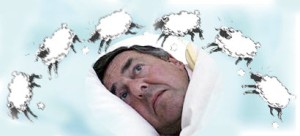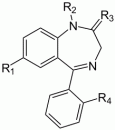 Index
Index

We spend about one third of our life sleeping. During sleep, the pineal gland and the hypothalmus in the brain stimulate the secretion of melatonin, human growth hormone, and other substances that give the body an opportunity to rebuild muscle tissues and allow neurotransmitter receptors to rest. Our need for sleep changes with age. Babies sleep 14 to 15 hours a day. Children between the ages of 5 and 12 years need to sleep 10 to 11 hours, and adults need approximately 7 or 8 hours of sleep.

The five phases of sleep.
Sleep proceeds through five stages characterized by different types of brain activity:
Stage 1 consists of light sleep
during which body movements slow down, but the legs or other muscles may have jerky movements.
In Stage 2,
eye movements stop and the brain activity is reduced.
Stage 3 consists of deep sleep. People waking from
this stage feel groggy and disoriented.
Stage 4 is a stage of restful sleep during which
the brain activity consists almost exclusively of
slow delta waves. People who do not spend enough time in Stages 3 and 4 will feel sleep deprived.
Stage 5 is called the "Rapid-Eye-Movement" (REM) stage. This is the
stage when dreaming occurs. During REM sleep, the breathing rate increases and becomes
irregular and shallow, the heart rate and blood pressure increase, and the eyes move
rapidly while other muscles become completely limp. REM sleep is often called "paradoxical sleep"
because the combination of increased brain activity with muscle atonia is unexpected.
The circadian rhythm or biological clock that regulates our sleep is influenced by the light and dark cycles of the day and night. The circadian rhythm is altered by intercontinental flights, artificial lighting, shift work, and many other aspects of our modern life. Disregarding the natural rhythms of nature can result in insomnia, automobile accidents due to fatigue, or the "jet-lag" effect felt by people traveling by airplane across many time zones. Sleep deprivation may cause paranoia, hallucinations, as well as cognitive and psychomotor impairments. The brain functions most easily disrupted by lack of sleep are memory, executive function, and attention span. In one experiment, people who drove after being awake for 17-19 hours performed worse than those with a blood alcohol level of .05 percent, which is the legal limit for drunk driving in many western European countries.[1]
Interpretation of Dreams
Dreams have always puzzled and mystified humans.
In biblical times, dreams were considered to be messages that foretold the future.
Chapter 41 of Genesis describes how Joseph, the eleventh son of Jacob, interpreted
the pharaoh's dream of seven lean cows eating seven fat cows as representing seven years of plenty and seven
years of famine. In 1899, Sigmund Freud published his book The Interpretation of Dreams
where he proposed that dreams are wish-fulfillments resulting from repressed or
frustrated sexual desires. These ideas were very influential in psychotherapy during the 20th century.
Today, dreams are considered to originate from free associations made during the organization and
consolidation of memory experiences of sensory stimuli perceived during the wakeful state
as well as during sleep.
Nightmares
Nightmares are very vivid dreams that appear to be real events and can cause fear, anxiety or terror.
Most nightmares occur during the rapid-eye-movement stage and they are so stressful that they
wake up the sleeper. Upon waking, the sleeper generally is able to remember the nightmare.
It is not uncommon for a person having a nightmare to wake up screaming or talking.
Sometimes nightmares occur when a
person is ill with a fever, or as a side effect of administration or withdrawal of psychoactive drugs,
such as sleeping pills. Nightmares may occur when an arm or a leg develops numbness or tingling,
or they may be triggered by other external stimuli such as flashes of light, unpleasant odors or strange noises.
Lucid Dreaming
Lucid dreaming or conscious dreaming is a problem-solving technique that tries to take advantage of
the free associations made during sleep.
The technique requires a person to become completely immersed in trying to solve
a problem. During the wakeful state, the problem is analyzed systematically and intensely
without distracting stimuli. During sleep, unusual and random associations
of the ideas studied during wakefulness can often provide insights for solving a problem.
During lucid dreaming, it is often possible to exert conscious control over the dream.
Sleep Disorders
The most common sleep disorders include:

Insomnia
Insomnia is a sleeping disorder characterized by persistent difficulty falling asleep or staying asleep.
People suffering from insomnia typically feel tired and cannot function properly while awake.
Insomniacs often complain that they are unable to rest their mind.
Organic insomnia caused by a physical impairment and non-organic insomnia are both considered sleep disorders.
Insomnia affects the body's ability to metabolize glucose. Individuals with insomnia and those who
sleep less than five hours per day have the highest risk of Type 2 diabetes.[2]
Home Remedies for Insomnia
For occasional insomnia, some people take over-the-counter medicines such as Tylenol PM, Nytol, or Benadryl
that contain diphenhydramine hydrocholoride. Diphenhydramine HCl is classified as an antihistamine
with sedating properties that causes drowsiness. It is not safe to operate machinery or drive a car
after taking this drug.



An age-old remedy for insomnia is taking a glass of milk close to bedtime. Dairy products are known to be good sources of the amino acid tryptophan. Tryptophan is a precursor of the neurotransmitter serotonin and of the hormone melatonin both of which induce and modulate sleep. Melatonin is available as a sleep-promoting aid in most pharmacies. The herb valerian is also used frequently as a remedy for insomnia, but dosages are difficult to determine due to the variability and lack of standardization of the available forms. Valerian is usually prepared as a tea consumed before bedtime.

What are benzodiazepines?
Benzodiazepines are psychoactive drugs with sedative, hypnotic, anxiolytic,
muscle relaxant, anticonvulsant, and amnesic properties.
Some of these drugs have a huge potential for abuse, as
benzodiazepines are amongst the most addictive medications
being freely prescribed today.
In spite of the great potential for abuse, benzodiazepines are widely used for treating anxiety, insomnia, agitation, seizures, muscle spasms, and alcohol withdrawal. Some common benzodiazepines are:
Sleeping Pills
Sleeping pills are medications that help to induce sleep. Sleeping pills are usually taken
for less than two weeks at a time. Sleeping aids work by
influencing the levels of tryptophan, serotonin (a calming neurotransmitter),
melatonin (a sleep-inducing hormone), or by altering brain chemistry in other ways.
Sleeping medications can have various side effects, including:
Sleeping pills can also become addictive, which is why there are many facilities where patients get treatment for sleeping pill addiction and get weaned off the medications.
Stopping sleeping medications abruptly may cause withdrawal symptoms such as anxiety, unusual dreams, cramps, sweating, nausea, vomiting, and shakiness. The following table lists some of the most commonly prescribed sleeping medicines.
|
Estazolam (ProSom, Eurodin) |
A benzodiazepine derivative with anxiolytic, anticonvulsant, sedative and skeletal muscle relaxant properties. May interact with many other medications. Can be habit-forming. |
|
Eszopiclone (Lunesta) |
Short-acting nonbenzodiazepine sedative hypnotic. May be used for a longer period of time than zolpidem or zaleplon. |
|
Ramelteon (Rozerem) |
Binds to the melatonin receptors in the suprachiasmatic nucleus (SCN) May interact with alcohol. |
|
Temazepam (Restoril) |
A benzodiazepine derivative. May interact with alcohol and many other medications. Can be habit-forming. |
|
Triazolam (Halcion) |
A benzodiazepine derivative. May interact with grapefruit juice, alcohol and many other medications. Can be habit-forming. Drug must be stopped gradually. |
|
Zaleplon (Sonata) |
Can be habit-forming. |
|
Zolpidem (Ambien) |
May lose effectiveness if taken for longer than two weeks. |
| Zolpidem (Ambien CR) | An extended-release formula that may be used for a longer period of time than regular zolpidem or zaleplon. |